Delicately variegated and beautifully toned, Chain of Hearts is one of the most wonderful trailing houseplants you can grow, but did you know that many species are native to Australia and will grow happily outdoors all year round?
Follow our guide to get to know this stunning vining succulent, so you can grow it to its best both indoors and out, and hopefully come away with more of an understanding of the varieties, species and cultivars of Chain of Hearts.
More...

Family: | Apocynaceae |
|---|---|
Genus: | Ceropegia |
Species: | Various |
Origin: | Widespread across Africa, Asia and Australia |
Common Names: | Chain of hearts, String of hearts |
Location: | Indoor and outdoor |
Type: | Evergreen, succulent, vine |
Growth: | 2-3 m long vines |
Sun requirements: | Bright but indirect light |
Foliage Colour: | Silvery green |
Flower Colour: | Salmon pink (rare indoors) |
Flowering: | Summer |
Edible Parts: | Some species have edible roots, but most are not considered edible |
Maintenance level: | Medium |
Poisonous for pets: | Non-toxic to cats and dogs |
Introducing Chain of Hearts
There are an unknown number of species of this widely spread and incredibly adaptable vining plant, found mostly throughout Australian and Asian hillsides, cliffs and forests.
Ceropegia, or ‘Chain of Hearts’, are, unusually, a tuberous vine, storing and producing energy for themselves, in order to produce sweeping vines that have been known to reach up to 4 m in length.
Their finely mosaicked leaves are variegated across every species and cultivar, and nearly all are, as their common name suggests, heart-shaped. They can be pruned to pretty much any size, cut back hard to control growth, or trained through any bright, sunny room.
In a conservatory or veranda, they can be grown in direct light for most of the day provided their small leaves are protected from being dried out by baking afternoon summer heat.
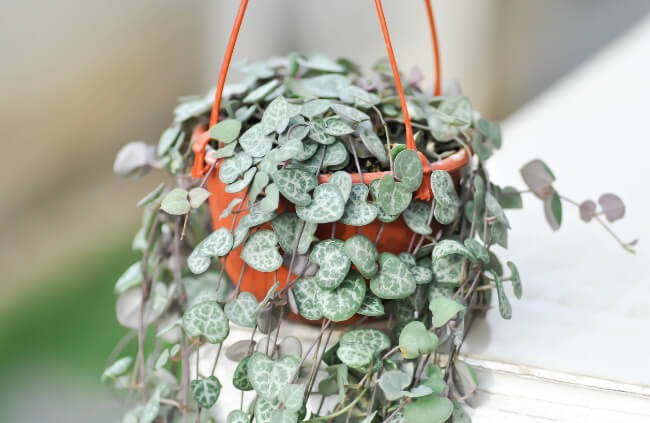
What is String of Hearts' Natural Habitat?
Chain of hearts, also called string of hearts, has varied habitats, including cliffs, forests and hillsides, as mentioned earlier. The shared characteristic of all locations is a combination of dappled light, excellent drainage, and good humidity, best described as humid tropical conditions.
Providing reasonable humidity, dappled light and decent drainage might sound quite complicated, but there is a space in nearly all homes where that’s achievable… the stairs (more on that later).
9 Best Varieties of Chain of Hearts to Grow at Home
There aren’t many commonly available cultivars of chain of hearts, but of the several-hundred species known, you should be able to find at least a dozen of them for sale from collectors and breeders online. And a handful in good garden centres too.
Native Ceropegia Species (Ceropegia cumingiana)
Ceropegia cumingiana is the only native Australian species of chain of hearts. Each individual leaf is about the size of an adult’s palm, sometimes with speckled variegations. It is strictly an epiphytic plant, growing on trees in humid, dappled light conditions.
In most parts of Australia, it can be grown both indoors and out, but is rarely grown as an ornamental because most imported species offer more delicate charm, and more versatile use both indoors and out.
Other Chain of Hearts Cultivars
There are thousands of species known around the world, but just a handful are sold regularly in cultivation. Those include (the most common) C. woodii, C. ampliata, C. haygarthii, C. linearis, C. sandersonii and C. stapeliiformis.
Each has distinct traits, and some have been the subject of intensive breeding, creating unusual and distinct cultivars.
Ceropegia woodii
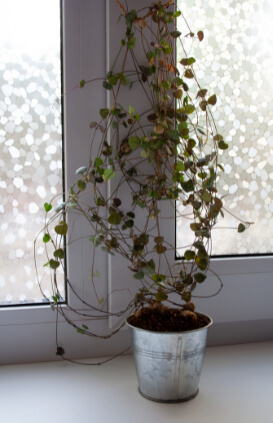
The most common chain of hearts is C. woodii, with softly variegated green leaves, each growing about an inch apart on a pale pink or cream coloured vine. In good light conditions, their leaves are closer together, but under stress they can become quite sparse, offering another, very dappled effect altogether.


Get Your Free Guide:
Master Growing Australian Natives eBook
A Must Have Complete Guide for Every Australian Garden
Get Your Free Guide:
Master Growing Australian Natives eBook
A Must Have Complete Guide for Every Australian Garden
There is also a variegated variety, sometimes sold as Ceropegia woodii var. Variegata and all Chain of Heart plants can be triggered into pink foliage as a result of low light or extreme light conditions.
Ceropegia woodii ‘Silver Glory’
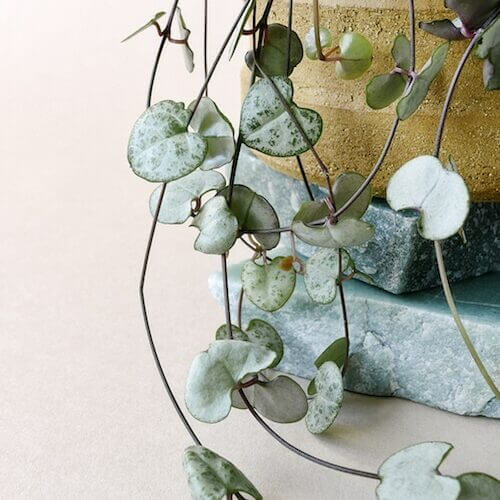
Source: Plant Circle
Ceropegia ‘Silver Glory’ has a distinctly white pigmentation at the centre of each leaf, framed by a deep reddish-green outline. Unusually, each leaf grows in a pair with another, mirroring itself on either side of the stem.
In dark rooms, or near a window, the silvery silhouette is just stunning, and isn’t really comparable to any other house plant.
Ceropegia woodii ‘Orange River’
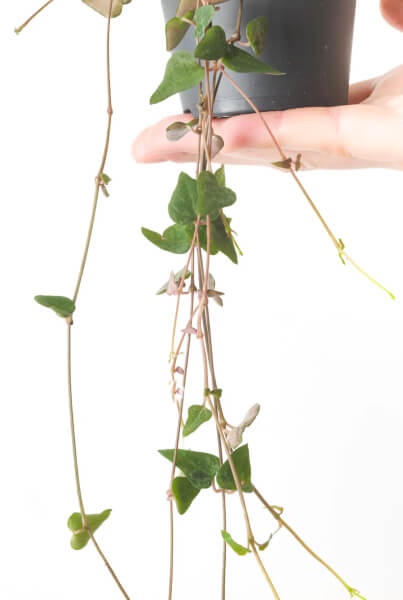
Source: GrowTropicals
The pointed, heart-shaped leaves of ‘Orange River’ are so distinctly heart shaped that they barely look real. Somewhere between ivy and a love-heart, they are just spectacularly beautiful trailing plants, which, like all C. woodii cultivars, can reach lengths of up to 4 m.
Ceropegia woodii ‘Heartless’
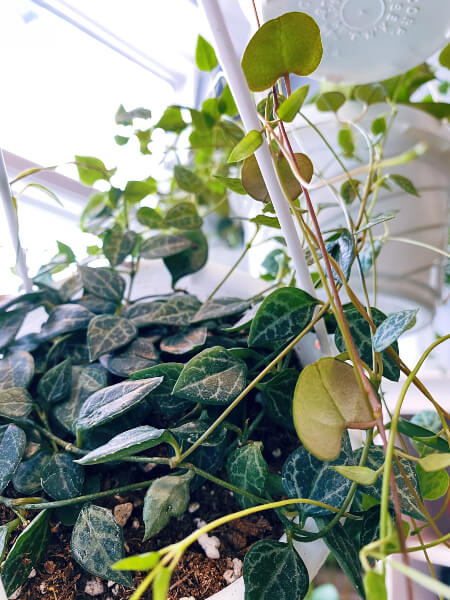
Source: Wild Willy's Plants and Flowers
Also called ‘Mini Star’, Ceropegia ‘Heartless’ has ivy patterned, pointed leaves, with little resemblance to the commonly given name of string of hearts, instead earning the title ‘string of daggers’.
It grows best in bright but indirect light, and doesn’t like to be moved. As the days start to get longer in spring, it’s worth pruning this often sparse cultivar to boost leaf density.
Ceropegia ampliata (Bushman’s Pipe or Condom Plant)
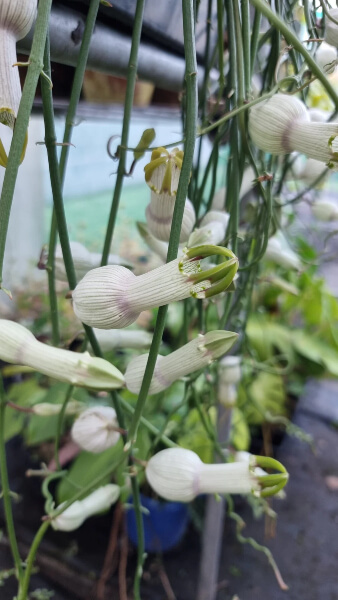
Source: Root'd Plants
A fascinating and unusual species of Ceropegia, but reliably available to buy as cutting or young plants online, is Ceropegia ampliata, whose leaves and stems form one, intertwined mass, topped with vase-like white flowers.
Often called Bushman’s Pipe or Condom Plant; both for obvious reasons, it is grown almost entirely for its unusual flowers.
Ceropegia haygarthii (Lantern Flower)

Source: Exotic Plants
This varied species has some variations, subspecies and distinct cultivars, but all have one thing in common; the incredible and beguiling lantern-shaped flowers, with elegantly structural ridged crowns at the tip of marbled tubes.
Their stems are usually found in a tangled mess, much like C. ampliata, but they do have small pairs of leaves at regular intervals along the stems.
Ceropegia linearis (String of Needles)
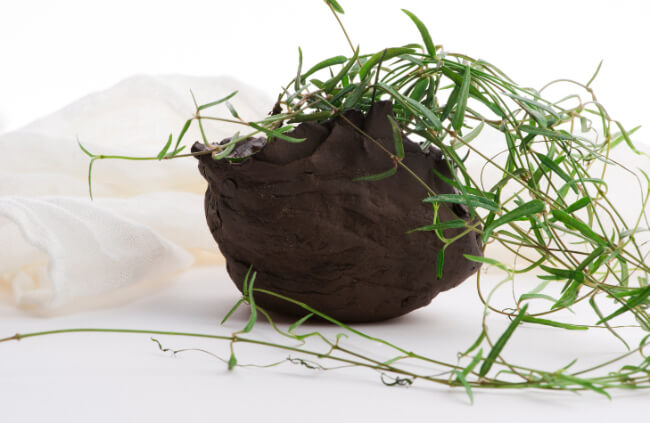
Care and conditions of Ceropegia linearis is basically identical to C. woodii, but it’s sturdier, tighter leaves are able to cope with slightly brighter conditions, and outdoor conditions without too much hassle.
Ceropegia sandersonii (Parachute Plant)
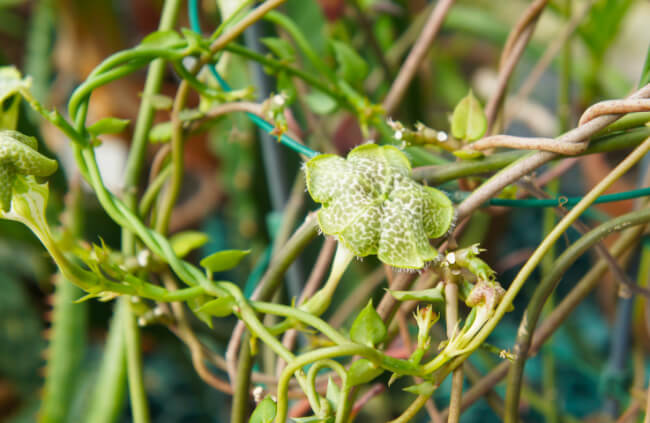
Shorter and denser than most in its genus, the Parachute plant, C. sandersonii, can be grown in pots, and trained upwards, or hung to train down. In either case, it’s important to offer filtered light, and good drainage, as well as seasonal temperature and light changes to trigger its ornate flowers.
Ceropegia woodiiThe most common chain of hearts is C. woodii, with softly variegated green leaves, each growing about an inch apart on a pale pink or cream coloured vine. In good light conditions, their leaves are closer together, but under stress they can become quite sparse, offering another, very dappled effect altogether. There is also a variegated variety, sometimes sold as Ceropegia woodii var. Variegata and all Chain of Heart plants can be triggered into pink foliage as a result of low light or extreme light conditions. |  |
Ceropegia woodii ‘Silver Glory’Ceropegia ‘Silver Glory’ has a distinctly white pigmentation at the centre of each leaf, framed by a deep reddish-green outline. Unusually, each leaf grows in a pair with another, mirroring itself on either side of the stem. In dark rooms, or near a window, the silvery silhouette is just stunning, and isn’t really comparable to any other house plant. |  Source: Plant Circle |
Ceropegia woodii ‘Orange River’The pointed, heart-shaped leaves of ‘Orange River’ are so distinctly heart shaped that they barely look real. Somewhere between ivy and a love-heart, they are just spectacularly beautiful trailing plants, which, like all C. woodii cultivars, can reach lengths of up to 4 m. |  Source: GrowTropicals |
Ceropegia woodii ‘Heartless’Also called ‘Mini Star’, Ceropegia ‘Heartless’ has ivy patterned, pointed leaves, with little resemblance to the commonly given name of string of hearts, instead earning the title ‘string of daggers’. It grows best in bright but indirect light, and doesn’t like to be moved. As the days start to get longer in spring, it’s worth pruning this often sparse cultivar to boost leaf density. |  Source: Wild Willy's Plants and Flowers |
Ceropegia ampliata (Bushman’s Pipe or Condom Plant)A fascinating and unusual species of Ceropegia, but reliably available to buy as cutting or young plants online, is Ceropegia ampliata, whose leaves and stems form one, intertwined mass, topped with vase-like white flowers. Often called Bushman’s Pipe or Condom Plant; both for obvious reasons, it is grown almost entirely for its unusual flowers. |  Source: Root'd Plants |
Ceropegia haygarthii (Lantern Flower)This varied species has some variations, subspecies and distinct cultivars, but all have one thing in common; the incredible and beguiling lantern-shaped flowers, with elegantly structural ridged crowns at the tip of marbled tubes. Their stems are usually found in a tangled mess, much like C. ampliata, but they do have small pairs of leaves at regular intervals along the stems. |  Source: Exotic Plants |
Ceropegia linearis (String of Needles)Care and conditions of Ceropegia linearis is basically identical to C. woodii, but it’s sturdier, tighter leaves are able to cope with slightly brighter conditions, and outdoor conditions without too much hassle. |  |
Ceropegia sandersonii (Parachute Plant)Shorter and denser than most in its genus, the Parachute plant, C. sandersonii, can be grown in pots, and trained upwards, or hung to train down. In either case, it’s important to offer filtered light, and good drainage, as well as seasonal temperature and light changes to trigger its ornate flowers. |  |
How to Grow Chain of Hearts in Australia
Chain of hearts can be grown both indoors and outdoors in nearly all parts of Australia, but it does need to be protected from cold temperatures, so should be brought indoors if there is any risk of frost, and ideally before it drops below 10°C.
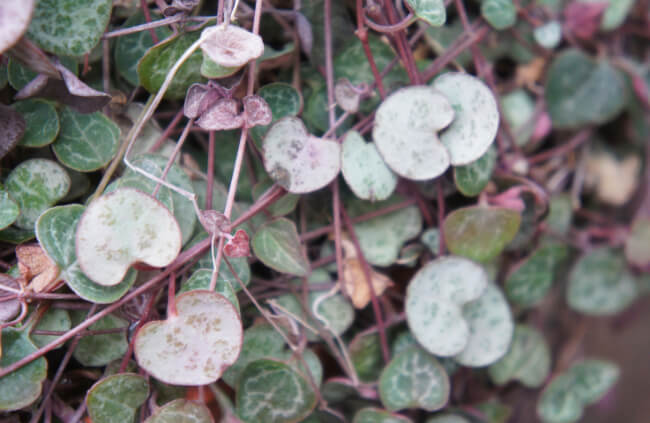
Ideal Conditions for Planting Chain of Hearts
Soil & Potting Mix
It is an epiphytic or lithophytic plant, meaning it naturally grows in crevices in rocks or trees, finding water where it can, and storing it in its small, succulent leaves, so potting compost should be well drained, and nutrient retentive.
Watering Needs
Chain of hearts should be allowed to dry out between every water. That means waiting for the leaves to just start turning pink. The leaves change to pink from their usual grey-green as they deplete their water reserves, signalling that it’s time to water the plant.
When you water your chain of hearts plant, water deeply, not by regularly sprinkling, and never if the soil is still moist.
Light Requirements
Chain of hearts like bright but indirect light. Think of the canopy of trees, or overhanging vegetation in nature that would shade it, and try to recreate that.
Indoors, frosted glass helps to filter light, while outdoors, covered verandas, or overhanging trees offer ideal conditions for chain of hearts.
Where to Grow Chain of Hearts Indoors
When it comes to finding the right spot for your chain of hearts, it’s all about light. Ventilation is key, allowing natural air flow, and a mix of carbon dioxide and oxygen to pass it by.
It’s also important to plant them somewhere visible, rather than hidden away, so you can clearly observe leaf colour changes and know when to water.
For me, that means one place, and one place only… the stairs. Stairs in most homes offer dappled light from nearby bright windows, as well as ventilation and air flow as the air we breathe out and the heat of our homes naturally causes upward movement of air past the staircase.
Obviously, it’s entirely up to you where you plant your chain of hearts, but it always looks wonderful draped through the bannister, trailing down into the hall.
Where to Grow Chain of Hearts Outdoors
Growing a chain of hearts outdoors can be a little bit trickier, as you’ll need to make sure it’s protected from wind, as well as very bright direct light. Some species do cope quite well with full sun, but most chain of hearts plants need some dappled shade.
While they can be grown outdoors in summer and brought indoors over winter, it’s worth considering the logistics of bringing an established, 4 m long set of vines back indoors without breaking them, or damaging them in some way.
If you live in warmer parts of the country, where frosts aren’t a risk, then consider growing chain of hearts in a well drained hanging basket, draped through pergolas or over seating areas.
Nature will do most of the work for you, but try to protect the soil from very heavy rainfall, and water when the leaves begin to turn pink.
How to Propagate Chain of Hearts
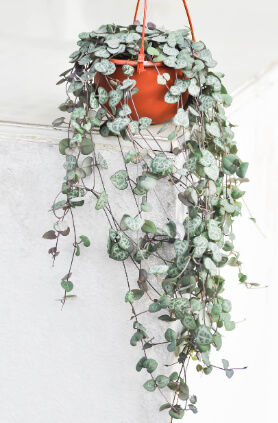
Rooting Chain of Hearts Cuttings in Water or Soil
Propagating chain of heart cuttings is relatively simple. All you need is water, and a healthy plant to start with. Cuttings can be anything from 5 cm to 20 cm long, and will root from each leaf node that is in contact with the water.
Rooting usually takes about two weeks, and will be easier to manage if you remove any leaves that will be underwater, simply to stop them from rotting.
Note: If you forget about your chain of heart cuttings and leave them for a couple of days before they even touch the water, don’t worry. Provided the leaves aren’t dry to a crisp, they should still work.
An even easier way to create a new chain of hearts is to circle shorter vines back into the pot, where they will nearly always root into the soil. These can be pricked out to create new plants, or left in situ to help thicken out leggy or thin plants, as they will grow down, without competing too much for nutrients.
Propagating Chain of Hearts Tubers
Another way to increase your stock of chain of hearts is through the tubers themselves, which, on healthy plants, can be found growing along the stem. You can either balance these tubers on some soil, while they are attached to the plant, or wrap moist tissue around them and wrap it in plastic film.
After a few weeks with reasonable moisture levels, and good contact with soil, tissue, moss (literally any rooting medium) the tubers should root, and be ready to cut from the plant, and bury into its own container, where they will sprout into multiple new vines.
Chain of Hearts Care Tips
Provided you don’t over or under-water your chain of hearts, most ongoing care for mature plants is optional. Feeding is a bonus, but not essential, pruning helps with visuals, but not health, and repotting makes your life easier, but does little for the plant.
Basically, just don’t worry too much. If your chain of hearts needs you, it will let you know.
Fertiliser
Chain of hearts doesn’t need much feeding. Either add a drip feed annually, or a very light liquid tropical plant food once a month in summer.
Pruning Chain of Hearts
If you ever see brown, dry, or crisp sections on your chain of hearts, cut them out. Equally, if some sections have been left too long without watering, they may create bare patches, leaving a generally thin overall effect.
You can cut these away, which will reinvigorate those vines, and encourage some branching to thicken the plant out within a couple of months.
Repotting
Chain of hearts shouldn’t ever need repotting. It will grow in the same container for decades. The only problem with that is that it will, by that point, have completely depleted its soil. That’s not the end of the world but it does mean that you need to water nearly every day, or constantly humidify the roots.
To make life easier, pot up your chain of hearts whenever the tubers are getting overcrowded. Split the plant in half as carefully as possible, untangling any vines that need removing.
Obviously, this is a big job, and it comes with risk, because chain of hearts are notoriously hard to move without breaking their vines or damaging leaves.
Common Sttring of Hearts Pests and Diseases
I’ve had a chain of hearts growing at home for nearly a decade. It’s had a mealybug infestation once, and spider mites once or twice. Aphids are a huge problem in our home, but I’ve never seen one on our chain of hearts.
Because the care for chain of hearts involves letting it dry out between waterings, spider mites are a natural problem, but there’s not really that much for them to eat. For the same reason, mealybugs struggle to exist as they can’t lay in dry soil, and aphids don’t have enough stems to populate.
If you do notice any of these common bugs on your chain of hearts, just spritz it with some diluted neem.
Disease and infection aren’t really a problem with chain of hearts. Overwatering can and will cause fungal problems, and rot, and severe underwatering can cause defoliation. Other than that there are no common viruses or diseases that affect them.
Chain of Hearts Frequently Asked Questions
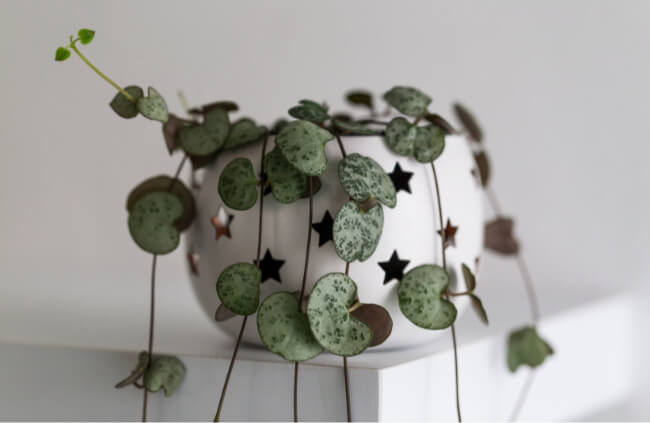
Is chain of hearts hard to care for?
Chain of hearts is really easy to care for. They are low maintenance plants that specifically don’t like being watered too often, making them a great plant for forgetful gardeners. Not only that, but they gently change colour when they need watering, so it’s impossible to forget.
Is chain of hearts toxic to pets?
Chain of hearts isn’t toxic to pets, it is safe for cats, dogs, rabbits and birds, and won’t harm livestock if it’s growing outdoors.
Does chain of hearts like to be misted?
Chain of hearts grows best with a relative humidity at 50%. Average homes are between 30-60%, so they shouldn’t really need misting, and it can over-humidify them.
Do chain of hearts prefer to hang or trail?
Chain of hearts, as is clear from any growing naturally outdoors, like to hang and drape, rather than trail in one long string. Leaving space between vines, and allowing them to create a fine curtain, rather than a thick rope is ideal.
Can chain of hearts grow in a bathroom?
Bathrooms are not a good place to grow chain of hearts. They are very humid rooms, and aren’t really bright enough. Chain of hearts likes bright, well ventilated spaces.
What are the white balls on my chain of hearts?
Chain of hearts are tuberous plants, producing swollen balls, or tubers along their vines, and duplicating tubers around the base. Tubers are most recognisable in the form of potatoes, and while string of hearts’ tubers aren’t a food source, they do store energy, and can be placed in soil to create new plants.
Does Chain of Hearts like shallow pots?
Chain of hearts likes shallow pots, or very well-drained pots. There should never be any soil that is more than 10 cm away from the air. While oxygen can penetrate soil down to a depth of 1 m easily, chain of hearts’ roots need very ready access to soil, so shallow pots are great.
What is the best window for Chain of Hearts?
The best window for chain of hearts is a North West-facing window, with plenty of late afternoon sun, but protection from direct midday light.
Wrapping Up Our Chain of Hearts Guide
Chain of hearts is one of the most dramatic and impressive houseplants you can grow, and it’s also one of the easiest to care for.
If you’ve ever struggled to grow things, or worry that your green thumb isn’t up to much, just take assurance from this guide that there is very little you can do to kill chain of hearts, and if you do, it’s often quite simple to recover them from cuttings.
Published on August 7, 2023 by Maisie Blevins
Last Updated on October 18, 2025




